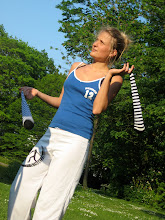 This picture I took from the airplane shortly before I arrived.
This picture I took from the airplane shortly before I arrived.The air and countryside is dry at this time of the year. Tonight, after more than 3 weeks of having been here, it rained for the first time!
 This picture I took from Marie's (my colleague) place, where I am staying temporarily. We could smell the smoke of the burning hill inside the house. Although it might also have come from somebody, burning his waste on the street.
This picture I took from Marie's (my colleague) place, where I am staying temporarily. We could smell the smoke of the burning hill inside the house. Although it might also have come from somebody, burning his waste on the street.The streets of Tegucigalpa ... after having been to Quito, Tegus seems like a small village: The streets are narrow, the traffic -mostly stuck in slowness- is not as threatening as in bigger cities. Yet, the black clouds that the old American schoolbuses leave behind are unsurpassable.
I am careful on the streets, trying not to step on cucarachas, orientating myself between whistling and kissthrowing men of all ages, watching out not to be followed, recognizing the beautiful blue sky with its colourful clouds during sunset while it is getting dark within minutes.
I walk home from work, wondering about the heavy life of the people here, feeling sometimes small and unworthy, next to the suffering, yet smiling women and children with worn-out feet and clothes - looking at me with big, curious, hopeful eyes.
Still, life in Honduras has a lot to offer!
 Even though it looks dry from above, lots of trees and plants reflect juicy fertility!
Even though it looks dry from above, lots of trees and plants reflect juicy fertility!CREATIVE THERAPY
I have started to integrate myself again within Arte Acción - lots of well-known faces and voices share the day with me while I work in the office.
During these weeks I have been updated by Marie - she is more than motivated - working intensively with her clients, who already have gone through some up- or deepgoing process in their personal therapy. The art therapy room is nicely decorated, there are quite a lot of materials, neatly put into shelves and boxes. On the door, there's Marie's calender - sometimes it is still a struggle to make appointments and really realize them, yet art therapy has gotten a much bigger priority within Arte Acción than before. The attended kids I talked to, seem proud and very happy to be in therapy. There is even a waiting list for more to come, who are longing for this personal, therapeutical, artistical attention.
 In a couple of workshops with some of the kids I tried to find out what they know, imagine and think when they hear the word creative therapy. I was very surprised to read and listen to their answers, as they have a good picture already of what our subject is about. (Later in this blog, I will summarize the answers of the youngsters - once I spoke to more of them)
In a couple of workshops with some of the kids I tried to find out what they know, imagine and think when they hear the word creative therapy. I was very surprised to read and listen to their answers, as they have a good picture already of what our subject is about. (Later in this blog, I will summarize the answers of the youngsters - once I spoke to more of them)  Thanks to the continuous work of three years, carried out by CT-students, Art Therapy is integrated more and more within Arte Acción. Me, then Miriam (check out her Dutch Weblog if you want to know more about her internship experience: www.miriaminhonduras.blog2blog.nl) and now Marie (visit her Blog, if you like to read in German www.marieenhonduras.blog.com).
Thanks to the continuous work of three years, carried out by CT-students, Art Therapy is integrated more and more within Arte Acción. Me, then Miriam (check out her Dutch Weblog if you want to know more about her internship experience: www.miriaminhonduras.blog2blog.nl) and now Marie (visit her Blog, if you like to read in German www.marieenhonduras.blog.com). 





















